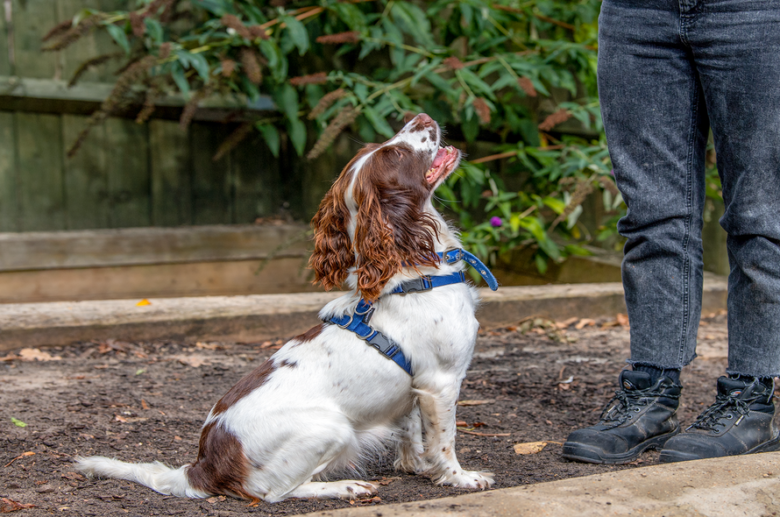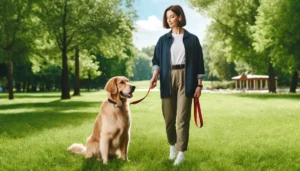Dogs communicate with each other the way humans do, but instead of using words, they use their bodies to express how they feel, what they want, and what they plan to do. Understanding dog body language is important for dog owners and anyone who works with dogs. It makes the relationship between people and dogs stronger and ensures that everyone gets along. This article describes the body language of different types of dogs to help you figure out what your furry friend is trying to say.
The Basics of Communicating with Your Dog:
Different parts of the dog’s body are used for interaction, such as the tail, ears, eyes, mouth and posture. Each of these things can tell you something about your dog’s mood, such as whether he is happy, scared, angry or obedient.
- Wagging Tail
Although a wagging tail is usually a sign of happiness, the type and position of the tail movement can indicate a wide range of emotions. A dog with a relaxed, wagging tail usually indicates contentment and happiness. On the other hand, a dog with a stiff and rapidly wagging tail may be excited or even angry. For correct interpretation, it is important to observe the tail and other body signals.
- Ear Positions
You can learn a lot about a dog’s emotions by looking at his ears. Dogs with erect and forward-tilted ears are usually alert and may be interested in something. On the other hand, ears flat against the head often indicate fear, submission, or a desire for peace.
- Eye Contact and Expression
Even in dogs, the eyes tell what’s inside. A calm and happy dog will have soft, relaxed eyes. On the other hand, an angry or challenged dog will have cold, staring eyes. Avoiding eye contact may mean giving up or feeling nervous.
- Mouth and Facial Expressions
A dog with a calm, slightly open mouth may feel happy and relaxed, while a dog with a closed mouth may feel nervous. Sometimes yawning is just a sign of tiredness, but it can also be a sign of stress. Licking your lips or showing your teeth can be a sign of nervousness or anger, respectively.
- Body Posture
The way a dog stands and walks can tell you a lot about how he is feeling. A calm posture with a straight back and no stress means that you are happy. A stiff, upright posture can mean someone is alert or angry, while a low, hunched body often means someone is scared or giving up.
How to Read Signals Together:
To understand a dog’s body language, observe all the signs together, not separately. It depends on the actual situation; what may be offensive behavior in one situation may not be dangerous at all in another.
Why Networking is Important:
Dogs need good socialization from an early age to learn how to use their bodies and talk to people and other dogs. Socialization helps people understand each other and interact well.
Most Common Misunderstandings:
Many people misinterpret dog body language, which can cause stress for both dogs and people. For example, a dog’s tail doesn’t always mean it’s nice, and not all growls mean it’s mean. Learning to understand the subtleties of your dog’s speech will help you avoid these mistakes.
Responding to Dog Body Language:
Reading your dog’s body language can help you know how to respond, whether that means giving him space, guiding him away from stress, or walking toward him without being aggressive. Knowing this can improve your relationship with your dog and his health.
How to Read Your Dog’s Body Language:
Pay Attention: Observe your dog in different environments and learn how he speaks.
Learn: You can learn how to read dog body language from many different places, including books, websites, and training courses.
Talk to an Expert: If you’re unsure about your dog’s behavior or body language, talk to a professional dog trainer or behaviorist.
Conclusion:
Learning to read a dog’s body language is a useful skill that can strengthen the relationship between humans and dogs. It helps us understand what our dogs need, tell them when they are stressed or unhappy, and respond to what they say in a way that builds trust and respect. If we learn how to talk to dogs, we can ensure their happiness and health, as well as our own.
FAQs:
1. How do I know if my dog is happy?
A happy dog typically exhibits a relaxed body posture, a wagging tail, soft eyes and a slightly open mouth that appears to be smiling. Their ears are in a natural position, neither backward nor exaggeratedly forward.
2. What does it mean when a dog avoids eye contact?
Avoiding eye contact can be a sign of submission or nervousness in your dog. It can also show that they are trying to de-escalate tensions and show that they are not a threat. However, context is important because it can sometimes mean they are distracted.
3. Can tail wagging indicate aggression?
Yes, a wagging tail can indicate aggression, especially if the tail is stiff and moving quickly. This type of tail wagging is usually more vigorous than relaxed wagging and should be considered a warning sign, especially if it is accompanied by other signs of aggression, such as exposed teeth or a stiff body position.
4. What does it mean when a dog yawns?
While yawning may simply mean that the dog is tired, it can also be a sign of stress, especially if it occurs in a stressful or new environment. Dogs may yawn to calm themselves or to let others know that they are anxious.
5. How should I respond to my dog’s body language?
Understanding your dog’s body language can help you respond appropriately to his needs and emotions. For example, if your dog shows signs of fear or anxiety, you can offer him comfort or relieve stress. If they are showing interesting body language, this can be a good time to communicate or play. Always consider the context and their entire body language to respond as effectively as possible.


